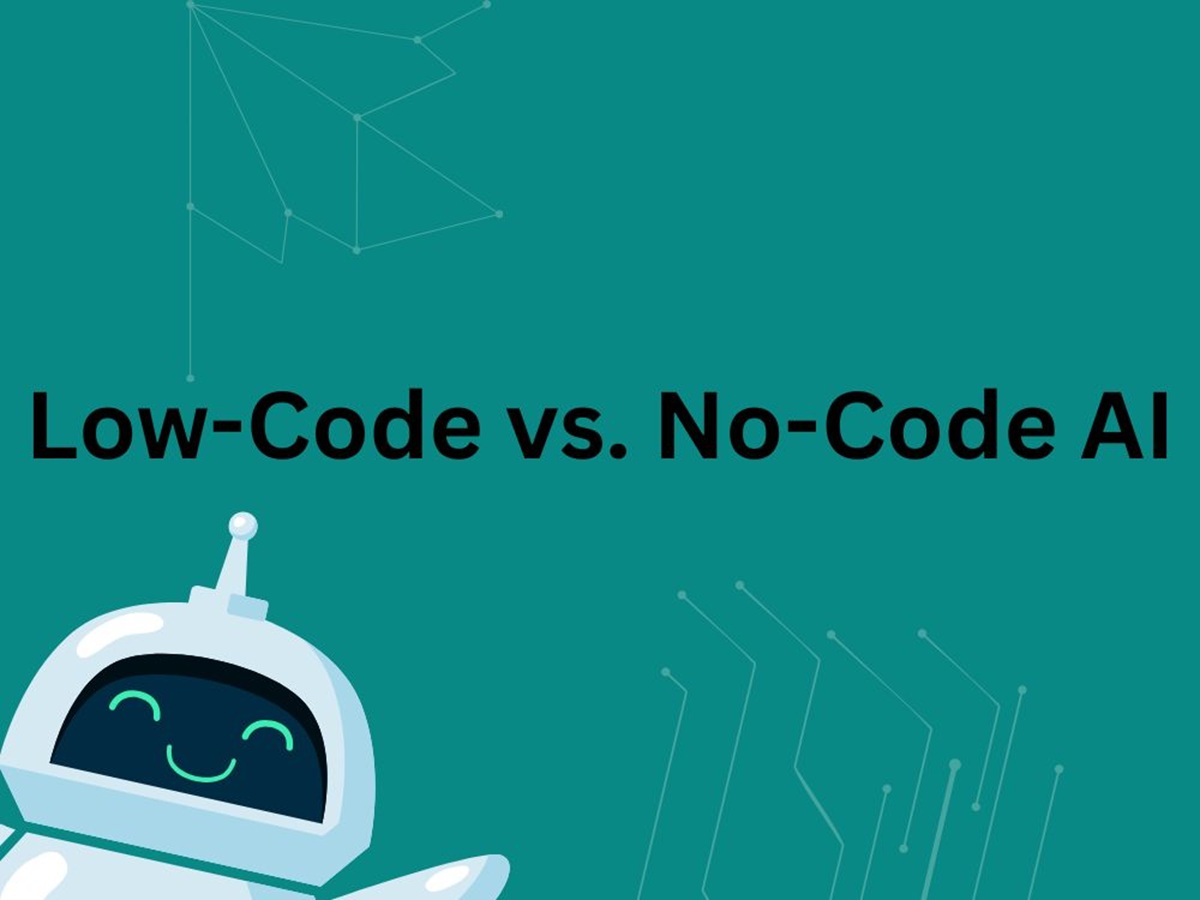Ever feel like artificial intelligence (AI) is a superpower reserved for giant corporations with massive budgets? For years, that was largely true. But in 2025, the game has completely changed. AI is no longer a far-off dream for small businesses; it’s an accessible, affordable tool that can help you save time, delight customers, and grow faster than ever before.
The problem has always been the barrier to entry. Most small businesses don’t have an army of expert developers or millions to spend on building custom AI from scratch. This is where two groundbreaking technologies come in: low-code and no-code AI. Think of them as the ultimate bridge, connecting your business goals with the power of artificial intelligence, without the need for a computer science degree.
So, how do you know which path to take? This post will explore the key differences, benefits, and ideal use cases for low-code and no-code AI. By the end, you’ll have a clear roadmap to help you choose the best approach for your small business needs in 2025.
Understanding the New AI Landscape for Small Businesses
Before we dive into the “how,” let’s quickly cover the “why.” AI is rapidly becoming a must-have for small and medium-sized businesses (SMBs) that want to stay competitive. Here’s why it’s so important:
- Automation of Repetitive Tasks: Imagine all the time spent on scheduling, sending follow-up emails, or sorting data. AI can automate these tasks, freeing you and your team to focus on what truly matters—growing your business.
- Enhanced Customer Experience: AI-powered chatbots can provide instant answers to customer questions 24/7, while other tools can help you personalize marketing messages, making every customer feel valued.
- Data-Driven Decision Making: Instead of relying on guesswork, AI can analyze your sales data, customer feedback, and market trends to give you clear insights, helping you make smarter, more profitable decisions.
- A Competitive Advantage: Using AI helps you operate more efficiently and effectively, leveling the playing field and allowing you to compete with larger companies.
Traditionally, achieving this required hiring expensive AI specialists and waiting months, or even years, for a custom solution to be built. This simply wasn’t feasible for most SMBs. Thankfully, that old way is no longer the only way.
Demystifying No-Code AI: Building with Digital LEGOs
What is No-Code AI?
Imagine building something amazing with a set of LEGOs. You don’t need to know how to manufacture plastic bricks; you just snap the pre-made pieces together to bring your vision to life.
That’s exactly what no-code AI is.
It’s a type of platform that allows anyone, regardless of their technical skill, to build AI-powered applications using visual, drag-and-drop interfaces and pre-built models. The target audience is business users, entrepreneurs, marketers, and any non-technical staff member who has a great idea but doesn’t know how to write code.
Key Features and Capabilities
- Pre-Trained AI Models: These platforms come with ready-to-use AI models for common tasks like image recognition (e.g., identifying products in photos), natural language processing (e.g., understanding the sentiment of a customer review), and predictive analytics.
- Intuitive User Interfaces: If you can use a presentation tool or a simple website builder, you can use a no-code AI platform.
- Rapid Deployment: You can go from an idea to a working AI application in a matter of hours or days, not months.
Benefits for Small Businesses
- Accessibility: Empowers your existing team to become “citizen developers,” building the tools they need without waiting for technical help.
- Speed: Quickly create and test prototypes. If an idea doesn’t work, you haven’t wasted significant time or money.
- Cost-Effectiveness: Drastically reduces the need to hire expensive developers or invest in complex infrastructure.
- Ease of Use: The learning curve is minimal, meaning you can start seeing results almost immediately.
Limitations of No-Code AI
The biggest strength of no-code—its simplicity—is also its main limitation. Just like with LEGOs, you are limited to the pieces provided in the box.
- Limited Customization: You can’t easily modify the core functionality of the pre-built models. If you need a very specific or unique feature, you might hit a wall.
- Dependency on the Platform: Your application’s capabilities are tied to the features offered by the no-code platform you choose.
- Scalability Concerns: While perfect for simple tasks, a no-code solution may struggle to handle extremely complex processes or massive amounts of data as your business grows.
Ideal Use Cases for No-Code AI in SMBs
- Automated Customer Support Chatbots: Easily build a bot for your website to answer frequently asked questions.
- Simple Data Analysis: Create dashboards that automatically categorize customer feedback or track sales trends.
- Marketing Automation: Set up systems that send personalized emails to customers based on their behavior.
- Basic Image or Text Classification: Build a tool to automatically sort product images or route incoming support tickets to the right department.
Exploring Low-Code AI: The Professional Kitchen Kit
What is Low-Code AI?
If no-code is like building with LEGOs, low-code AI is like having a professional-grade kitchen kit. It comes with high-quality, pre-built appliances and templates (the visual tools), but it also allows you to bring in your own special ingredients and write your own recipes (custom code).
Low-code platforms bridge the gap, offering a combination of visual development and the ability to add minimal hand-coding for greater control and customization. This makes it perfect for “citizen developers” who have some technical aptitude or for professional developers who want to build applications much faster.
Key Features and Capabilities
- Pre-Built Components and Templates: Speeds up the development process by providing a solid foundation to build upon.
- Extensibility with Custom Code: This is the key difference. If a pre-built component doesn’t do exactly what you need, you can write a small piece of code to extend its functionality.
- Better Integration: Offers more robust tools to connect your AI application with other existing systems your business relies on, like your CRM or accounting software.
Benefits for Small Businesses
- Flexibility and Customization: You get the best of both worlds—the speed of visual development and the power of custom code.
- Scalability: Low-code solutions are built to handle more complexity and can grow with your business.
- Deeper Integration: Seamlessly weave AI into your core business processes by connecting it to your existing software stack.
- Accelerated Development: It’s significantly faster than traditional coding but offers far more power than no-code.
Limitations of Low-Code AI
- Requires Some Technical Skill: While you don’t need to be an expert, you or someone on your team will need a basic understanding of programming concepts to take full advantage of its features.
- Steeper Learning Curve: It takes more time to master a low-code platform compared to its no-code counterpart.
- Potentially Higher Cost: The initial setup and subscription fees for low-code platforms can sometimes be higher than no-code options.
Ideal Use Cases for Low-Code AI in SMBs
- Custom CRM/ERP Features: Build an AI-powered lead scoring system directly into your customer relationship management software.
- Advanced Analytics: Create a predictive model that forecasts inventory needs based on your unique sales cycle and seasonal trends.
- Complex Automated Workflows: Design a multi-step workflow that requires specific business logic, like a custom insurance claim processing system.
- Unique AI-Powered Applications: Build a custom mobile app for your business that includes unique, AI-driven features.
Low-Code vs. No-Code: Making the Right Choice
So, which one is right for you? The answer depends entirely on your specific goals, resources, and vision.
Here’s a simple decision framework. Ask yourself these four questions:
- What problem are you trying to solve?
- Choose No-Code if: You need a fast, simple solution for a common business problem (e.g., a standard chatbot, an email sorter).
- Choose Low-Code if: You need a tailored solution for a unique or complex business process that requires custom logic.
- What are your team’s skills?
- Choose No-Code if: Your team is entirely non-technical. You want to empower marketers, sales staff, or office managers to build their own tools.
- Choose Low-Code if: You have someone on your team with basic coding knowledge, or you’re willing to work with a freelance developer to handle the custom parts.
- What is your budget and timeline?
- Choose No-Code if: Your top priorities are speed and keeping initial costs as low as possible.
- Choose Low-Code if: You are willing to invest a bit more time and money for a more powerful, scalable, and long-term solution.
- How might your needs change in the future?
- Choose No-Code if: You are focused on solving a specific, immediate need and don’t foresee major changes.
- Choose Low-Code if: You anticipate your business growing and your AI needs becoming more complex over time. You want a solution that can grow with you.
Don’t forget, you can also use a hybrid approach. Start with a no-code tool for a quick win, like automating your social media posts. As you grow, use a low-code platform to build a more sophisticated, custom analytics dashboard that tracks the success of those posts.
Best Practices for Implementing AI in Your Small Business
No matter which path you choose, following these best practices for 2025 will ensure your success:
- Start Small and Iterate: Don’t try to automate your entire business at once. Pick one specific, manageable problem, launch a small pilot project, and gather feedback before expanding.
- Data Quality is King: A common saying in AI is “garbage in, garbage out.” Your AI is only as good as the data you give it. Ensure your data is clean, relevant, and organized. Always prioritize data privacy and security.
- Train Your Team: The best tool is useless if no one knows how to use it. Educate your team on how the new AI works and, more importantly, how it will make their jobs easier.
- Measure Your Return on Investment (ROI): Define what success looks like. Are you trying to save time, reduce costs, or increase customer satisfaction? Track these metrics to prove the value of your investment.
The Future is Bright (and Easy to Build)
The world of low-code and no-code AI is just getting started. We are heading toward a future where AI is even more accessible. Soon, generative AI will be integrated into these platforms, allowing you to simply describe the application you want to build in plain English, and the AI will help design it for you.
As this technology becomes more powerful, it’s also crucial to focus on responsible AI—ensuring the tools we build are fair, transparent, and free of bias.
Your AI Journey Starts Today
For small businesses in 2025, low-code and no-code platforms have torn down the old barriers to AI. They offer two powerful but distinct paths to innovation.
- No-Code AI is your ticket to speed and simplicity, empowering anyone on your team to build simple, effective AI solutions quickly.
- Low-Code AI is your path to power and flexibility, offering the ability to create highly customized, scalable solutions that are perfectly tailored to your business.
The most important takeaway is that there is no single “best” choice—only the best choice for your business. By evaluating your needs, skills, and future goals, you can confidently step into the world of AI. Don’t wait to be left behind. Start exploring these amazing technologies today and give your small business the superpower it deserves.


